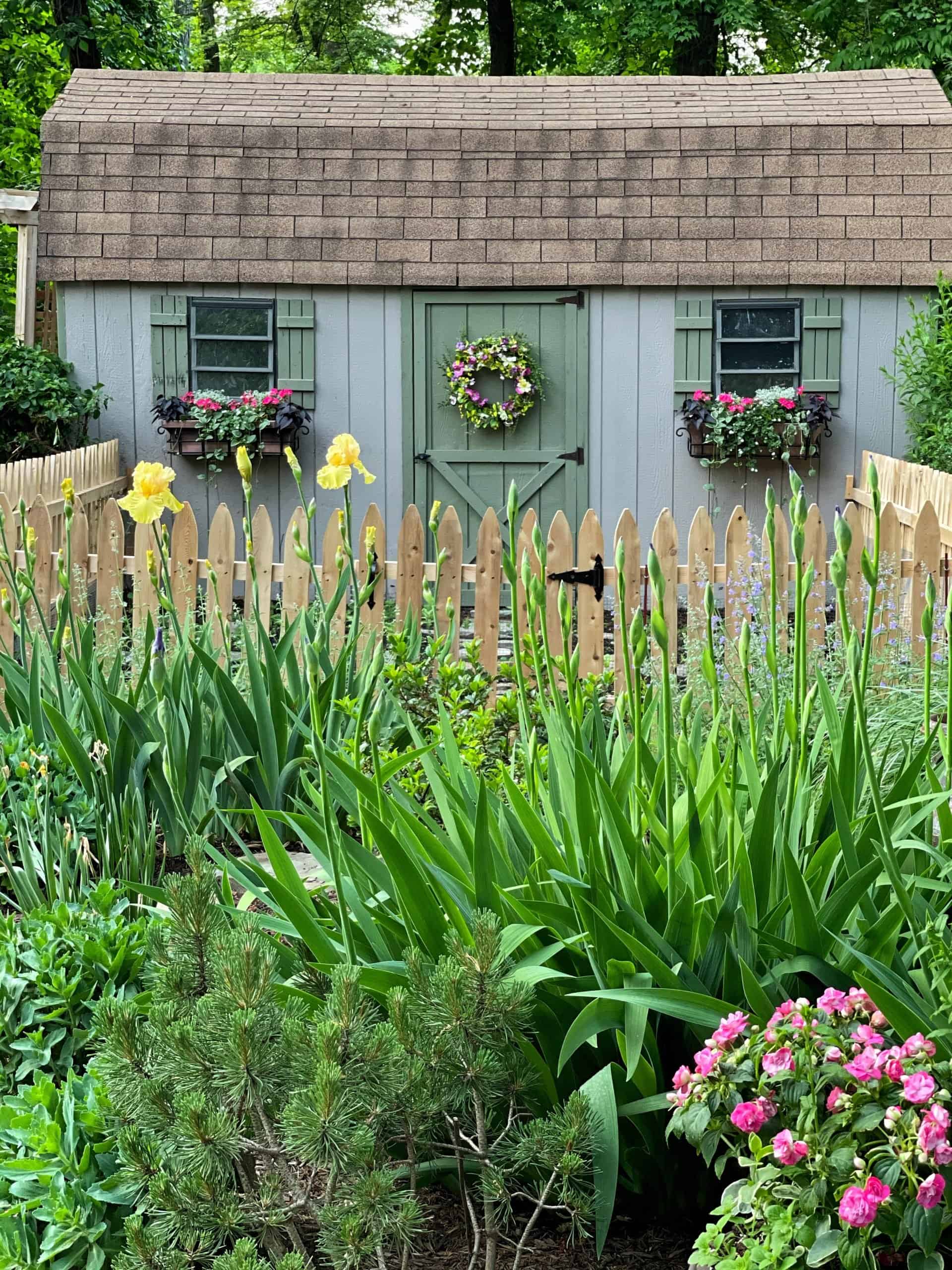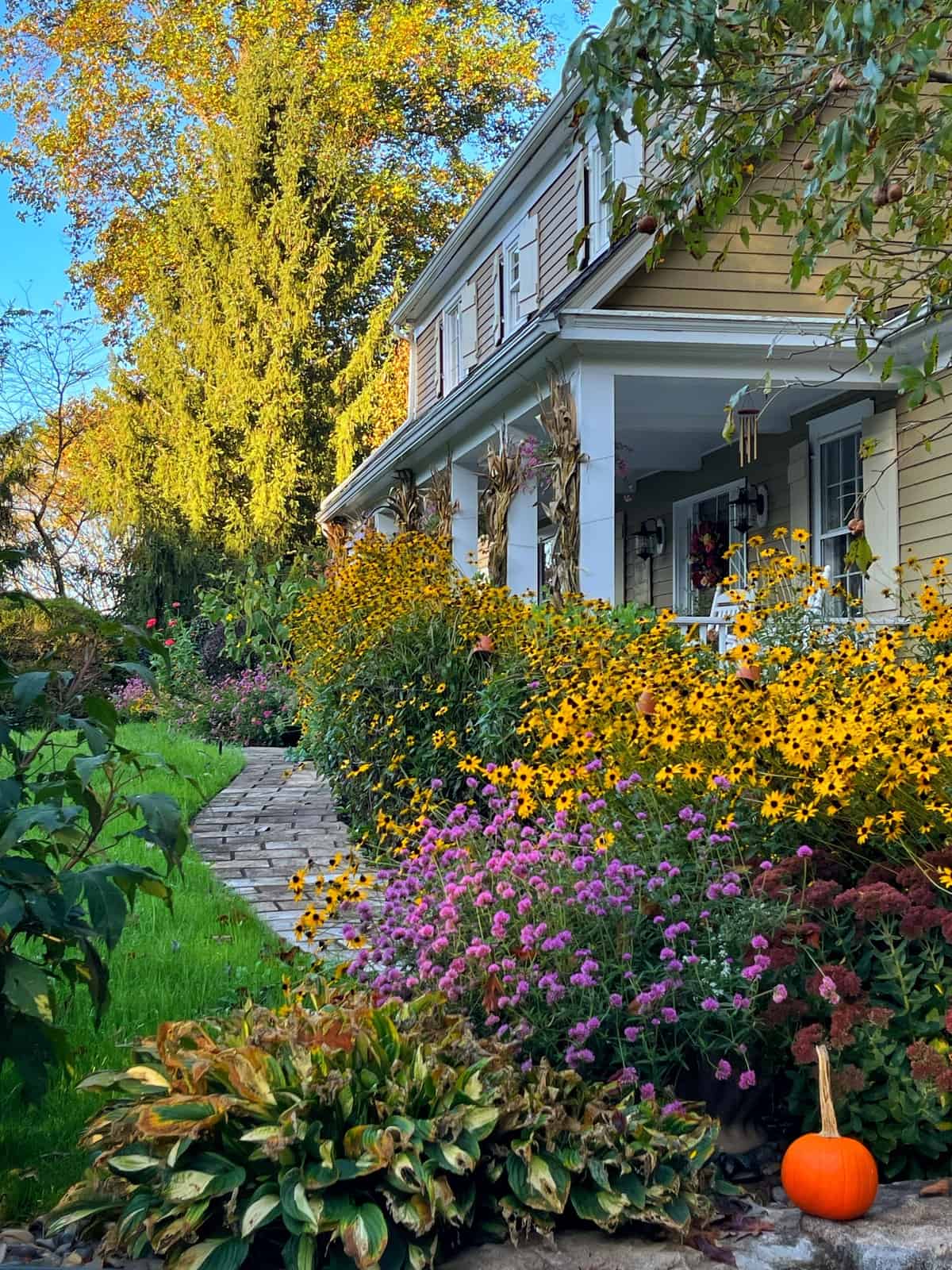Learn how to create stunning window boxes with my top tips for planting flowers. Perfect for adding beauty to your home all year round.
Want to instantly boost your home’s curb appeal? Stunning window boxes brimming with flowers are a fantastic way to do it! But their charm isn’t limited to windows. From creating captivating centerpieces to adding life to balconies and decks, these versatile planters offer endless possibilities. This guide is packed with our best tips for planting gorgeous, thriving window boxes, helping you bring a burst of color and life to any space – big or small.
(Posts on stacyling.com may contain affiliate links. Click HERE for full disclosure.)

Why Window Boxes Enhance Your Home’s Curb Appeal
Window boxes filled with colorful flowers can significantly boost the aesthetic appeal of your home. They add a touch of nature right outside your windows, making your home look more inviting and well-maintained.
Whether you have a traditional or modern home, the right one can complement your architecture and color scheme beautifully. Plus, they’re a great way to showcase your gardening skills and creativity.
Choosing the Right Planters
When selecting window boxes, consider the material, size, and style that will best suit your home’s exterior. Here are some popular options:
- Wooden Boxes: Classic and versatile, wooden boxes can be painted or stained to match your home. They’re sturdy but may require more maintenance to prevent rot.
- Metal Boxes: These add a sleek, modern touch and are very durable. However, they can be heavy and might need additional support.
- Plastic and Fiberglass Boxes: Lightweight and low-maintenance, these boxes come in various styles and colors. They’re also resistant to weather damage.
Consider the size of the box as well; it should be proportional to your window and provide enough space for your plants to grow.
For my garden shed, I chose these gorgeous metal planters that are coated with a beautiful copper finish. They’ve got a pretty vintage antique scroll frame that I love and they complement the shed well.

Selecting the Best Flowers
Before purchasing flowers, we should examine where our window boxes will be maintained. Does the area receive full sun, part sun, or shade? Understanding the location will help you choose the right plants. If you aren’t sure how much sun or shade an area gets, watch it for one full sunny day.
- 6-8 hours of direct sunlight means you have full sun
- 4-6 hours means you have partial
- And 4 or less means you have shade
Beyond light conditions, you’ll also want to look at watering needs because some plants don’t need as much water as others. Thus, understanding light and water conditions will help you take better care of your plants and keep them thriving.

Shopping for Window Box Flowers
Once you’ve determined the location, it’s time to shop for plants. When selecting plants, ensure they have similar light and water requirements for the best results. Start by reading the plant tags to understand each plant’s needs. This will help you choose the right plants and increase your chances of success.
- Full Sun: If your containers will be in full sun, choose plants that can tolerate bright light and some dryness. In the heat of summer, window boxes can dry out quickly, especially if they aren’t in self-watering planters or have drip systems. Opt for sun-loving flowers like petunias, marigolds, and geraniums. These plants thrive in direct sunlight while adding vibrancy.
- Shade: For shaded containers, select shade-tolerant plants like impatiens, begonias, and fuschias. They flourish in low-light conditions and bring a soft, lush look to your planters
- Mix and Match: Combine different types of flowers to create a dynamic display. Pair tall, upright flowers with trailing plants like ivy or sweet potato vine for added depth and texture. Coleus is always a great option because it can handle different light conditions, flowers, and has great foliage color.

Designing a Window Box Garden
While shopping around the nursery, I was looking for plants that would accentuate the planters and could handle lower light conditions. One of the things I like to do is group my plants together in the nursery to see how they look together. Are they aesthetically pleasing?
I look at foliage, blooms, plant size, and the overall plant habit. When designing a container garden, I use the thriller, filler and spiller method of design. To learn more about thriller, filler, and spiller, please read my article about planting in containers.
What Should I Plant in My Window Box?
There are lots of pretty plants and flowers that look amazing in window boxes. Depending on the location (sun, part sun or shade), you’ll want to design them accordingly. Keep in mind that soil and plants carry a lot of weight, particularly after it rains. So make sure you reinforce the window boxes so they don’t fall off the building. (It’s happened to me before). Some of the flowering annuals that I enjoy using in my window boxes include:
- Petunias
- Pansies
- Euphorbia
- Sweet Potato Vine
- Geraniums
- Ivy
- Vinca
- Impatiens
- Begonia
- Bacopa

Step-by-Step Guide to Planting Flowers in Window Boxes
Now that we’ve got our window boxes and flowers chosen, let’s pot up our window boxes. Before we start planting, it’s a good idea to get all of your supplies together. Here’s what you’ll need.
Supplies Needed
- plants
- planter box
- potting soil
- weed fabric (make sure it is not plastic)
- gloves
- scissors
- plant food
- hand trowel or cup
Since my shed is in full sun, I am planting annuals that will thrive in full sun and look beautiful with the copper planters. My full sun window box flowers and plants include:
- Geraniums
- Sweet Potato Vine
- Bacopa
- Euphorbia
- Vinca

Preparing Your Planters
Start by cleaning your window box and ensuring it has proper drainage holes. If your planters lack drainage, grab a drill and add some. A good potting mix is essential; use a high-quality mix that retains moisture but also drains well.
Planting Window Box Flowers
Gather supplies and if possible, remove the window box and work from a table. In many cases, this isn’t possible, and that’s OK. But it is much easier to pot them on a table if you can.
- Cut weed fabric to size to fit inside the planter. This will help keep the soil in instead of washing out every time you water.
- Begin by arranging your plants while they’re still in their pots. Place taller plants at the back and trailing plants at the front.
- Add some potting soil with a hand trowel or cup so the plants have some soil to sit in.
- Check the planting depth by adding your plants while still in their plastic nursery pots. You want the soil line to match up with about an inch down from the top of the container. If more soil is needed to get the right depth, add more.
- Gently remove plants from plastic pots and fan out the roots before setting in the container. This encourages the roots to grow out into the potting soil.
- Backfill with potting soil, tamping it down as you go to remove the air pockets.
- Add a slow-release fertilizer to the container, water, and enjoy!
When planting your window box, you’ll want to arrange your plants in a way that creates a balanced and visually pleasing display. You can use different heights and textures to add interest and don’t be afraid to mix and match different plants for a unique look.


Maintaining Your Planters
Regular watering is key, especially for window boxes in full sun. Consider using self-watering planters to make the task easier. I run drip irrigation kits set on timers to all of my window boxes, hanging planters, and container gardens so it is set and forget. These are especially useful for window boxes as they tend to dry out really fast during hot summer. Not to mention all the time you save manually watering.
Fertilize with a balanced fertilizer to keep your plants healthy and blooming. You can use a water soluble one that needs reapplication often. I like to use this slow-release fertilizer so I feed them once at planting and don’t have to do it again.
Finally, it’s important to deadhead spent flowers to encourage new blooms and maintain a neat appearance. This will keep your window box planters looking lush and beautiful all season long!

Seasonal Window Box Ideas
- Spring: Fill your boxes with tulips, daffodils, and pansies for a burst of spring color.
- Summer: Heat-tolerant flowers like marigolds, zinnias, and petunias are perfect for summer.
- Fall: Add a mix of chrysanthemums, ornamental kale, and pansies for autumn hues.
- Winter: Use evergreens, holly, and winter-blooming pansies to keep your boxes vibrant even in the cold.
DIY Tips for Success
Get creative with your box planters by decorating them with paint, stencils, or decorative brackets. Consider planting herbs like basil, thyme, and parsley for a functional and beautiful display. Add small garden ornaments or fairy lights to enhance the look, especially in the evening.
Common Mistakes to Avoid
- Underwatering: Because these types of planters dry out more quickly, it’s important to be vigilant with watering practices as mentioned above.
- Poor Drainage: Ensure your window boxes have adequate drainage to prevent root rot.
- Ignoring Light Requirements: Choose plants that suit the light conditions of where you are maintaining them.

Creating Stunning Window Boxes FAQ
How Often Should You Water a Window Box?
Because window boxes can dry out much easier than larger planters, frequent watering is a must, particularly during the summer. Or you’ll need to use plants that can handle drier conditions, like succulents. Unless you add an irrigation system set on a timer, you may need to water your window boxes 1-2x a day in the heat of summer. Keep an eye on your plants to make sure they do not wilt.
Why You Should Consider Using Self-Watering Planters
Self-watering window boxes are perfect for those who want to grow plants with minimal maintenance. Here are the key benefits:
- Consistent Moisture: These boxes have a reservoir that provides consistent moisture to the soil, ensuring healthy plant growth.
- Reduced Maintenance: They reduce the frequency of watering, as the reservoir can keep plants hydrated for several days or weeks.
- Less Water Waste: The design minimizes water waste by releasing water only as needed, which is ideal for dry climates.
- Improved Plant Growth: Consistent moisture reduces water stress, promoting healthier plants and larger yields for edibles.
Self-watering containers offer convenience and efficiency, making plant care easier and more effective. When using self-watering planters, make sure you add enough support to hold the additional water, soil, and plants because it can get very heavy and you don’t want them falling off your house.

How Wide Should a Window Box Be to a Window?
The width of a window box should generally be equal to the width of the window or slightly smaller, depending on the size and style of the window. This will ensure it fits properly and looks proportional to the window. If the window is very large, you may want to consider using multiple window boxes or a larger planter that spans the width of the window.
Additionally, it’s important to make sure that the window box is deep enough to accommodate the roots of the plants you plan to grow. A depth of at least 6 inches is recommended for most plants but if you can, I’d go deeper so it doesn’t dry out as quickly. Just make sure you reinforce the boxes so it holds the additional weight of soil and plants.

Should Window Boxes Have Drainage Holes?
Yes, window boxes need drainage holes to allow excess water to escape. Proper drainage is crucial for the health of the plants because it prevents water from collecting at the bottom, which can lead to root rot and other issues.
Without drainage holes, water can become trapped, suffocating the plant roots and potentially causing them to die. Drainage holes enable excess water to drain out, preventing these problems.
If your planter doesn’t have drainage holes, you can drill some yourself. Ensure the holes are large enough to allow water to escape but not so large that soil falls out. Adding a piece of weed fabric at the bottom can help keep the soil in while allowing water to drain out.
How Do You Attach a Box to a Window?
There are several ways to attach a window box to a window, depending on the type of window and the window box itself. But the best way to do it is by using brackets and screws.
Many window boxes come with brackets and screws that attach to the sides of the window box and then to the window itself. These brackets are typically made of metal and are designed to fit over the windowsill or be screwed into the wall beneath the window.
Another option is to create a load-bearing shelf with brackets to support it to hold the weight of soil and plants. Before attaching the window box, it’s important to make sure that the window and surrounding area are clean and free of any debris that could interfere with the attachment method.
Additionally, always follow the manufacturer’s instructions for installing the window box to ensure that it is attached securely and safely.

What type of soil is best for window boxes?
A high-quality potting mix that retains moisture and drains well is ideal.
Can I plant vegetables in window boxes?
Yes, herbs and small vegetables can thrive in window boxes. You’ll want to ensure the window box is deep enough to accommodate their root systems.
How many plants should be in a window box?
When determining how many plants you should include in a window box, consider the garden design idea that the eye breaks spaces in thirds. So choose an odd number of plants (3, 5, 7 or 9) and stuff them in the planters. If the gardening season is short like it is here in my zone 6b hardiness zone, I suggest planting them tightly so you get a full look from the outset and fewer weeds pop up.
How do you organize plants in a window box?
Before planting, move your plants around in the window box until you get an aesthetically pleasing look. Be sure to include both flower and foliage plants, but make sure they are balanced and not all grouped on one side or the other. Stand back and ask yourself if the window box looks symmetrical. If it looks good, then pot it up!
Final Thoughts About Planting Window Boxes
Creating stunning window boxes is a fun and rewarding project that adds beauty to your home all year round. With the right plants and a little care, you can transform your windows into vibrant, colorful displays that brighten up your home’s exterior. Happy gardening!
For more information about planting flowers in window boxes, please read this article from Clemson Cooperative Extension.
Do you plant window boxes around your home? What do you like to plant? Let’s chat more in the comments below.
To drill down on more beginner gardening techniques and tips, please read these posts:
- Flower Gardening 101
- Growing a Cut Flower Garden for Beginners
- Container Garden Ideas for Beginners
- How to Start a Vegetable Garden
- Herb Gardening for Beginners
Thank you for visiting the blog today!
Enjoy your day! xo


Shop for Window Boxes
There are lots of different window box options to shop for. Choose one that will look good with your home and speaks to your personal style.
Click here to shop these affordable and beautiful window boxes for your home and garden.













After completing the renovation of our garden shed, we added these adorable stainless steel planters with an antique copper finish. I love how the copper finish looks with the paint color on the shed, don’t you? New window box planters mean more opportunities to plant pretty plants and flowers.
So let’s warm up the garden shed with some flowering annuals. Follow these window box gardening tips for designing and planting that will add curb appeal to your home.





